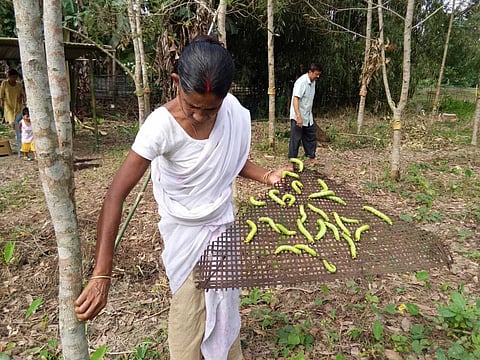
- Home
- Live Blog
- Breaking News
- Top Headlines
- Cities
- NE News
- Sentinel Media
- Sports
- Education
- Jobs

A CORRESPONDENT
LAKHIMPUR: Causing an alarming threat to the diligent sericulture cultivators, the change in climate and unfriendly weather have hit the Muga industry in Dhakuakhona subdivision of Lakhimpur district of late. A week-long unfriendly weather with consecutive showers of rain and finally a lash of hail has caused the death of muga silk worms in the subdivision.
As many as 10,000 families of the subdivision are directly involved in the rearing of muga silk worms, thereby contributing to the sericulture sector of the State. Like the previous years, average 20 families of each village under the subdivision were busy in cultivating the winter season muga silk worms during the last three months this year too. This batch of the muga silk worm is most important to the cultivators concerned in order to produce the required seeds to rear the October batch (locally known as Katia muga) for commercial purposes.
But last week, change in weather and heavy downpour affected the muga silk worms, therby rendering the three-month long rigorous labour of the muga cultivators meaningless. In the wake of a heavy shower of hail that occurred on Wednesday, the muga silk worms started dying in various parts of the subdivision. This pitiable condition has made them suffer a great loss. In the subdivision, thousands of muga silk worms died alarmingly in the last week of April and first week of May last year too. The non-judicious use of insecticides and pesticides in the growing small tea gardens was considered to be the main reason of the unexpected phenomenon.
The north-eastern region is enriched with sericulture bio-diversity and the place is believed to be the origin place of Antheraea species in the world. Muga silk is produced by a worm of Antheraea Assama species which is confined only in north-eastern India. The intensive cultivation of this worm is found in the Brahmaputra Valley of the State. Lakhimpur district in general and Dhakuakhona subdivision in particular is the traditional muga growing area in the world.
As per reports there are 10,000 traditional muga cultivators in the sub-division who are actively involved in this culture covering an area of about 1,600 hectares land with muga food plants. In most cases, these cultivators are not integrated regarding muga production but they have conserved the culture and respective bio-resources through interlinking it with their crop cycle since the time immemorial. They are unknowingly following the principle of sustainable agriculture with this endeavour. It provides them a way to earn their bread and thus production of muga silk has assumed the status of an industrial system. Apart from generation of income and employment, muga cultivation can be utilized for environmental upgradation too by expanding the muga growing areas with muga food plantation, that is Machilus odoratissima, locally known as Chom Gash.